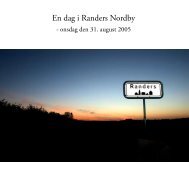Forankring af kvarterløft - Tverskov Kommunikation & Udvikling
Forankring af kvarterløft - Tverskov Kommunikation & Udvikling
Forankring af kvarterløft - Tverskov Kommunikation & Udvikling
Create successful ePaper yourself
Turn your PDF publications into a flip-book with our unique Google optimized e-Paper software.
Summary<br />
By og Byg Documentation 029<br />
Urban development programmes and institutional sustainability<br />
Area-based urban development programmes such as Kvarterløft – apart<br />
from being spatially targeted and operating an integrated set of political and<br />
administrative instruments – are characterised by being limited in time.<br />
Moreover, it is a distinct feature of the Danish Kvarterløft projects that a<br />
considerable transfer of economic and other resources take place in the<br />
course of the project period. Consequently, the issue of continuation is<br />
naturally raised towards the end of the project period. In what way are<br />
activities expected to go on beyond the official termination of the project?<br />
Are the activities financially viable and institutionally sustainable? Has a<br />
strategy for phasing-out been prepared? Who holds the responsibility and<br />
takes over when project management and st<strong>af</strong>f are no longer there? Is it<br />
likely that the social, institutional, and physical improvements that have been<br />
achieved will prevail in the future and that further deterioration in the<br />
neighbourhood has been prevented?<br />
The first generation of in total seven Danish Kvarterløft projects was<br />
launched in 1996-97, some of which were officially closed <strong>af</strong>ter five years at<br />
the end of 2001. Others have been extended for another two years. Due to a<br />
request from the central Government’s Kvarterløft office, the project leaders<br />
have been preparing a so-called exit strategy before official termination of<br />
the projects.<br />
– This report takes its point of departure in existing evidence of how to<br />
ensure that a take-over from temporary (urban) development projects –<br />
be it by community-based or local government-based bodies – will<br />
continue to be well-functioning. It appears that the future sustainability of<br />
the changes and improvements that have been accomplished during a<br />
project primarily depends on the institutional capacity of the organizations<br />
that take over. This in turn relies on four factors:<br />
– governance mode and distribution of responsibility,<br />
– local ownership and local partnerships,<br />
– finance and day-to-day operation,<br />
– follow-up and learning.<br />
An exit strategy that aims to ensure the institutional sustainability of the<br />
achieved progress – and the actual organizational implementation of it – has<br />
to take the above points into consideration. However, the specific design of<br />
such a strategy will vary depending on the circumstances of the single<br />
project and its setting.<br />
Based on the study of exit strategies of the Danish Kvarterløft projects<br />
and interviews with planners and stakeholders, the analysis distinguishes<br />
between three different approaches to project termination. The first model is<br />
a Division of Labour Model in which future tasks are shared between<br />
community organizations on the one hand and local government on the<br />
other. The local community-based organizations take over responsibility for<br />
the future running of the completed projects. The responsibility of the local<br />
authorities at municipal level is confined to projects originally planned but yet<br />
not completed. The responsibility to plan and prepare possible new project<br />
rests with the community itself.<br />
43



